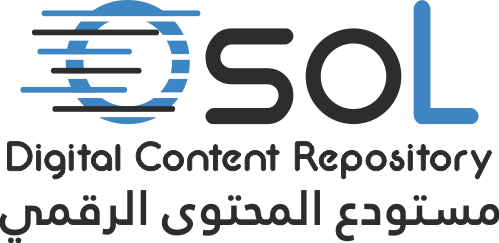Please use this identifier to cite or link to this item:
https://dspace.qou.edu/handle/194/2657Full metadata record
| DC Field | Value | Language |
|---|---|---|
| dc.contributor.author | Yousef Khader Issa Rajabi | - |
| dc.date.accessioned | 2022-02-20T07:51:48Z | - |
| dc.date.available | 2022-02-20T07:51:48Z | - |
| dc.date.issued | 2022 | - |
| dc.identifier.uri | https://dspace.qou.edu/handle/194/2657 | - |
| dc.description.abstract | This study aimed to present a suggested visualization for blended educational supervision in Palestinian public schools in the northern governorates from the point of view of school principals and educational supervisors, considering the independent variables (gender, occupation, educational qualification, years of experience, directorate, and type of school). A random sample was selected, consisting of (584) educational supervisors and principals during the 2021/2022 academic year. Questionnaire tool was used for collecting quantitative data related to the problem of the study, which included seven areas: administrative and technical requirements, supervisory requirements, infrastructure, communication processes, degree of technological awareness, and obstacles. Whereas focus groups were used to collect qualitative data to obtain in-depth information. The results showed that the field of administration obtained a high degree, and the areas of using communication applications, digital infrastructure, competencies in the use of computer applications, supervisory competencies, follow-up and direction of management, communication with the parties to the educational process, communication security, and the availability of interaction with the parties to the educational process obtained a medium degree. The results showed that there are (13) obstacles to the integrated educational supervision, the most influential of which is the lack of cooperation between educational supervisors, school principals and teachers, the absence of technical specialists, in addition to the lack of availability of necessary equipment in schools. The results showed that there were no statistically significant differences in the average responses of the study sample members at the significance level (α ≤ .05) regarding all areas of blended educational supervision; it is attributed to the variables of gender, occupation, and type of school. While the results showed that there were statistically significant differences in the average responses of the study sample members at the significance level (α ≤ .05) regarding all areas of blended educational supervision; it is due to the variables of academic qualification, years of experience, and directorate. The study was able to present a suggested model for the blended educational supervision. The study recommended officials in the Ministry of Education to adopt the presented model and apply it in Palestinian public schools. | en |
| dc.language.iso | ar | en |
| dc.publisher | جامعة القدس المفتوحة/Al-Quds Open University | en |
| dc.subject | Educational Supervision, Blended Educational Supervision, Palestinian Public Schools | en |
| dc.subject | الإشراف التربوي، الإشراف التربوي المدمج، المدارس الحكومية الفلسطينية. | en |
| dc.title | A suggested visualization for blended educational supervision in Palestinian governmental schools in the northern governorates from the point of view of principals and educational supervisors | en |
| dc.type | Thesis | en |
| dc.description.arAbstract | هدفت هذه الدراسة إلى تقديم تصور مقترح للإشراف التربوي المدمج في المدارس الحكومية الفلسطينية في المحافظات الشمالية من وجهة نظر مديري المدارس والمشرفين التربويين، في ضوء المتغيرات المستقلة (الجنس، والوظيفة، والمؤهل العلمي، وسنوات الخبرة، والمديرية، ونوع المدرسة)، واستخدم المنهج المختلط، واختيرت عينة عشوائية وفق مرحلتين مكونة من (584) من المشرفين التربويين ومديري المدارس الحكومية الفلسطينية في المحافظات الشمالية خلال العام الدراسي 2021/2022. واستخدمت الاستبانة كأداة لجمع البيانات الكمية المتعلقة بمشكلة الدراسة، والتي احتوت على سبع مجالات هي المتطلبات الإدارية والفنية، والمتطلبات الإشرافية، والبنية التحتية، وعمليات التواصل، ودرجة الوعي التكنولوجي، والمعوقات، واستخدمت المجموعة البؤرية لجمع البيانات النوعية من أجل الحصول على معلومات متعمقة حول ما تم جمعه باستخدام أداة الاستبانة واستجابات حول التوجهات نحو استخدام الإشراف التربوي المدمج. وأظهرت النتائج حصول مجال الإدارة على درجة مرتفعة، وحصول مجالات استخدام تطبيقات التواصل، والبنية التحتية الرقمية، وكفايات استخدام التطبيقات الحاسوبية، والكفايات الإشرافية، ومتابعة وتوجيه الإدارة، والتواصل مع أطراف العملية التعليمية، وأمان الاتصال، وإتاحة التفاعل مع أطراف العملية التعليمية على درجة متوسطة. وبينت النتائج وجود (13) معوقاً للإشراف التربوي المدمج، وأكثرها تأثيرا تمثل بقصور التعاون بين المشرفين التربويين ومديري المدارس والمعلمين، وعدم مشاركة المجتمع المحلي في دعم الإشراف التربوي المدمج، وعدم وجود مختصين مؤهلين فنياً في حل المشكلات التي تواجه المشرفين التربويين، بالإضافة إلى عدم توفر التجهيزات اللازمة في المدارس. وأظهرت النتائج عدم وجود فروق ذات دلالة إحصائية في متوسطات استجابات أفراد عينة الدراسة عند مستوى الدلالة (α ≤ .05) فيما يتعلق بمجالات الإشراف التربوي المدمج كافة؛ تعزى لمتغيرات الجنس، والوظيفة، ونوع المدرسة. بينما أظهرت النتائج وجود فروق ذات دلالة إحصائية في متوسطات استجابات أفراد عينة الدراسة عند مستوى الدلالة (α ≤ .05) فيما يتعلق بمجالات الإشراف التربوي المدمج كافة؛ تعزى لمتغيرات المؤهل العلمي، وسنوات الخبرة، والمديرية. واستطاعت الدراسة أن تقدم تصوراً مقترحاً لنموذج للإشراف التربوي المدمج. وأوصت الدراسة المسؤولين في وزارة التربية والتعليم تبني النموذج المقدم وتطبيقه في المدارس الحكومية الفلسطينية. | en |
| dc.contributor.arAuthor | يوسف خضر عيسى رجبي | - |
| dc.arTitle | تصور مقترح للإشراف التربوي المدمج في المدارس الحكومية الفلسطينية في المحافظات الشمالية من وجهة نظر مديري المدارس والمشرفين التربويين | en |
| Appears in Collections: | Educational Administration and Supervision - ماجستير الإدارة والإشراف التربوي | |
Files in This Item:
| File | Description | Size | Format | |
|---|---|---|---|---|
| Yousef_Rajabi.pdf | 5.5 MB | Adobe PDF | View/Open |
Items in DSpace are protected by copyright, with all rights reserved, unless otherwise indicated.
